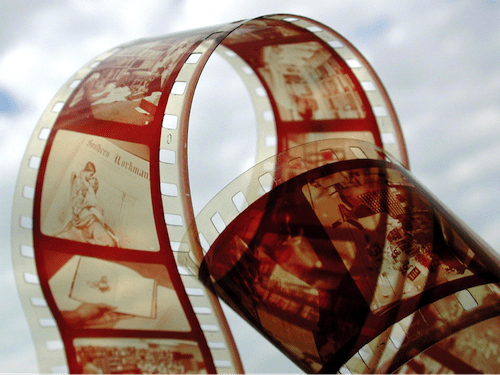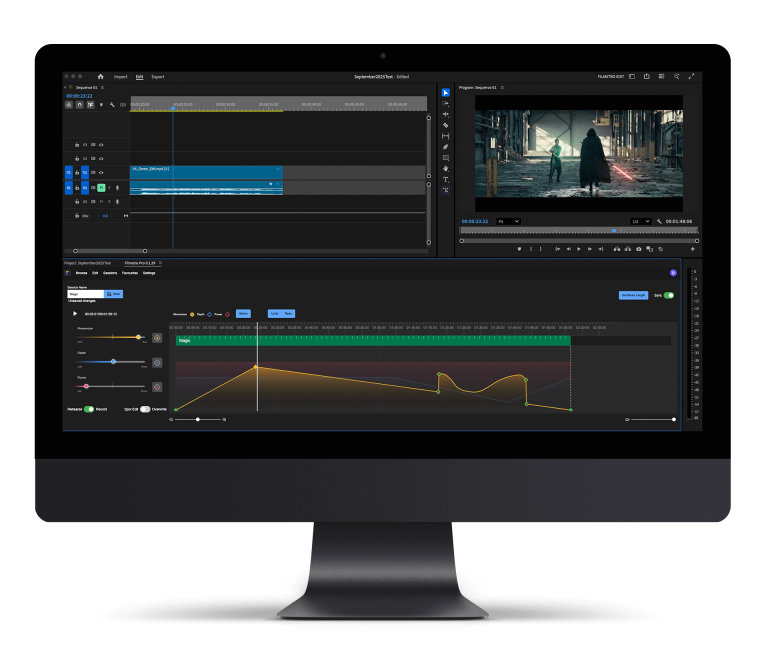What Is Celluloid Film? Exploring The History And The Present –
Filmmakers use innovative filmmaking tools to enhance their storytelling. Digital devices are plenty, and there is a level of accessibility to filmmaking that has never been seen before. Despite our innovative future, it is important to revisit filmmaking’s roots and gain inspiration through historical filmmaking methods.
Celluloid film is an integral part of the film industry. It was used in the industry for over a century. Celluloid film was the only way major movies could be filmed and distributed during the industry’s inception.
If you are a budding filmmaker or an established filmmaker, understanding the history of celluloid film can help you inspire and innovate.
This celluloid film guide will make you an expert on this monumental art of filmmaking.
Let’s begin!
What Is Celluloid Film?
Celluloid film is a type of flexible plastic sheet that was invented in the 1800s. This film sheet was made from nitrocellulose, camphor, and alcohol.
The first celluloid film was created by a French inventor named Louis Le Prince. The original celluloid film was later developed and improved by Thomas Edison and Eastman Kodak.

The plastic used in celluloid film was different as it could be used repeatedly. This plastic was also free from dangerous chemicals such as BPA and phthalates. Celluloid film was first used as a photographic film. Later, it quickly became the most popular film stock for recording and capturing motion pictures and animation.
Celluloid film was popularly used for motion pictures during the 1880s and the 1950s. However, celluloid consists of a transparent thermoplastic that makes a much sturdier and more durable option than early filmmaking tools. Before the invention of celluloid films, filmmakers used glass plates and paper roll films.
Celluloid film was originally available in black and white, but after 1922 it was produced in clear or transparent with coloured dyes available to make negatives.
The Word “Film”
The word film came about due to the use of celluloid. For the longest time, movies were only available and distributed on film. Even though filmmaking methods have become digital, the name has still stuck.
Components Of A Celluloid
These are the components of a celluloid film:
- A flexible plastic strip that is divided into frames. These frames have perforation on the side, so the strips could easily be fed through a projector or camera.
- Celluloid contained nitrated, which made it explosive, and it had to be handled with care.
- Celluloid gave the film a natural film grain when projected.
How Are Motion Pictures Recorded Using Celluloid Film?
Films are recorded on celluloid film by exposing the gelatin emulsion on the film to light. This causes a chemical reaction in the crystals that develops into a visible image.
The images on the film are projected onto a movie theatre screen using a movie projector. This process made it possible for us to see our movies.
What is Celluloid Film Made of?
Celluloid is made from nitrocellulose and camphor oil. Camphor is a natural substance found in some trees. These elements were dissolved in alcohol to create the film. Celluloid is also known as nitrate by some manufacturers. However, this is misleading as nitric acid was a common key ingredient for film development.
The use of Nitric acid was made popular by American inventor and manufacturer George Eastman. Eastman introduced the first Kodak camera and was credited with the popularity of amateur photography. In 1888, the first Kodak camera celluloid rolls. This event became a turning point in the history of celluloid film.
When celluloid film was first used for motion pictures, it was not a popular choice due to the hazardous materials. Movie theatre owners were hesitant to use cellulose as they were worried the theatre might catch on fire and harm moviegoers. Early celluloid contained cellulose acetate, which burns easily and releases toxic fumes when exposed to heat or flame.
Celluloid needs to be handled with care as it can develop mould if it is not stored properly. Celluloid can also break down over time when exposed to light or moisture. Despite requiring a lot of upkeep, celluloid provided the flexibility needed in the motion picture industry.
The use of celluloid in film production was discontinued in 1952 due to high danger risk, but today, several safety measures are undertaken when producing this type of film.
A Brief History Of Film
The first publicly available photographic film was Dageureotype. This film was first introduced in 1839 by Louis-Jacques-Mandé Daguerre. The Daguerreotype was popularly used for 20 years until newer and cheaper photography methods were developed.
In the 1850s, glass plate photography became the standard for most cameras in the industry. Glass plates offered better optical quality than early transparent plastics and Daguerreotype. This became the best photography method until George Eastman introduced his inventions to the photography world.
In 1885, Eastman introduced the first “flexible photographic roll film.” The first transparent plastic roll entered the market in 1889 and was made from nitrocellulose or celluloid. This invention led to the creation of the Eastman Kodak Company.
The Kodak Company is credited with leading the photographic film movement and establishing how a film should be used. Kodak is a vital part of the motion picture industry, and Kodak’s inventions paved the way for the movie we see today. Kodak reigns as possibly the largest provider of physical film to this day.
During the twenty-first century, the age of the digital revolution began. Many filmmakers began using digital filmmaking methods as opposed to analog film. Directors George Lucas and Steven Soderbergh began experimenting and embracing digital film as soon as it was introduced. George Lucas’ Star Wars: Episode II – Attack of the Clones (2002) was the first major film to get a digital release in major markets. By the 2010s, digital filmmaking became the norm, and many movie theatres switched to accommodate all the digitally-produced films.
The First Celluloid Film
British photographer John Carbutt became the first person to use Celluloid film. The oldest recorded short film was created in 1888. This film was called Roundhay Garden Scene, and inventor Louis Le Prince filmed it.

The film was shot on location at Oakwood Grange in Roundhay, Leeds, and it is considered to be the oldest surviving film ever to exist. The film was black and white and looked rough around the edges. When you look at this film, you see just how far the motion picture industry has come!
After the production of Roundhay Garden, film finally got its push from Thomas Edison’s Kinetoscope and the Lumiere Brothers’ Cinematograph. These two inventions popularised celluloid film and helped create the film industry base we know today.
The Kinetoscope
When Edison’s invented the first Kinetoscope, it was intended for single-person use only. The person would use the device to exhibit moving images. The kinetoscope is not similar to a movie projector. However, it did introduce the basic approach that became a standard for all cinematic projection.
The kinetoscope would create the illusion of movement by displaying a strip of perforated film. This film strip contained images in a sequenced order. The strip would be put over a light source with a high-speed shutter to project the images and display movement.
When the kinetoscope gained popularity, the Lumiere brothers decided to take this concept and elevate it. The Lumiere brothers had already established themselves as titans of Europe’s photography industry, and they had the means necessary to build innovative film equipment.
The Lumiere brothers wanted to take Edison’s concept and change it so that they could show their moving pictures to multiple people at the same time. They created a machine that could capture moving images and would be able to project them to a wider audience.
Their invention could also print these images for other people’s viewing needs. This new device would also create a commercial need for the product. Despise the innovation; their device was only ¼ the size of Edison’s device.
Since the Lumiere camera was compact in size, it created new ways for people to create shots. There was flexibility with the Lumiere device that had never been experienced before. People now had the ability to create varying shots, and they could also move the camera however they wanted. Such a compact design leads to creative filmmaking methods.
Filmmakers could transport this camera all over the world, and they could show audiences sights they had never seen before. The invention of this device leads to a boom in the film industry. More and more people were eager to enjoy films, and the Lumiere brothers themselves created over a thousand films. The Lumiere brothers created a blueprint for how storytelling should be done with a camera.
Filmmaking In The 1900s
As more filmmakers got acquainted with the Lumiere camera, the film industry expanded. Production companies were starting up; a whole new group of filmmakers was formed, and celebrity culture began.
Between 1910 and 1927, silent narrative films became the norm for people around the world. By 1916, there were 21,000 movie theatres in the United States alone. Silent films remained popular for around two decades.
During the era leading up to and during World War II, people wanted a different moviegoing experience, and filmmakers wanted to experiment further with their devices. Many production studios considered using sound alongside their moving picture to elevate the field of filmmaking even further. In 1900, the first known public display of projected synchronised sound films happened in Paris. This set the early groundwork for what films would become in the 21st century.
The 1900s were a great time of innovation in the film industry. The early celluloid film went through multiple iterations during this time, and the groundwork laid by the film led to a revolution in the movie-making industry.
Celluloid Filmmaking Today
When celluloid films were the norm in the filmmaking industry, people didn’t understand what made this medium so special. It was only after the creation of digital filmmaking that people understood how important celluloid film was to the birth of cinema.
When the film industry switched from celluloid film to digital, many creatives in the film industry pushed for the use of celluloid. Due to this demand, many professional and amateur filmmakers have begun reexamining the importance of celluloid filmmaking.
Directors like Quentin Tarantino and Christopher Nolan are big believers in celluloid film, and they continuously encourage people to film and watch on celluloid. A few of their films have been re-released on celluloid. Outside of prestige filmmakers, many indie directors also prefer using celluloid instead of digital or along with digital for their movies.
Greta Gerwig’s Little Women (2019) and Noah Baumbach’s Marriage Story (2019) were both shot and presented on film in some instances. For many filmmakers, the aesthetic of celluloid is what attracts them to use film instead of digital. Celluloid can also give motion pictures an incredibly high resolution.
Celluloid Film Examples

Throughout the decades and since the invention of celluloid, many films have employed this filmmaking method. Some of the most iconic films that used celluloid include:
- The Wizard of Oz (1939)
- Casablanca (1942)
- West Side Story (1961)
- The Graduate (1967)
- A Clockwork Orange (1971)
- The Shining (1980)
- Blade Runner (1982)
As you can see from this list, celluloid filmmaking has reigned supreme for many decades; however, during the 1990s, more and more digital films started cropping up. During this decade, the film industry experienced a major shift in filmmaking methods.
However, many filmmakers are still using film to shoot their movies. There have been more than 100 films shot on celluloid in the past three years. These include:
- The Irishman (2019)
- Once Upon a Time in Hollywood (2019)
- The Lighthhouse (2019)
- On The Rocks (2020)
- Wonder Woman 1984 (2020)
- The French Dispatch (2021)
- No Time To Die (2021)
This list just scratches the surface and shows us that celluloid filmmaking is still in demand. Celluloid film is still used for blockbuster movies, as evidenced by No Time To Die and Wonder Woman 1984.
Final Takeaway
Celluloid filmmaking was a pioneer in the filmmaking industry, and it has established the groundwork for films we see today. While crafting new ways of filmmaking is always beneficial, it is also important to look back and appreciate the innovations of the past.
Even though digital can replicate the look of a movie shot on film, it can never replicate the history contained in that small strip of plastic.
If you liked “What Is Celluloid Film? Exploring The History And The Present“, you should also check out Professional Video Editing
We hope you enjoyed this article and don’t miss out on any of our other blogs!
Sign up to Filmstro and follow us on Twitter, Facebook and subscribe to our Youtube channel. You can also check out some of our amazing royalty-free music today by clicking here.








